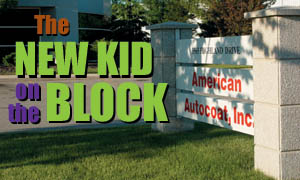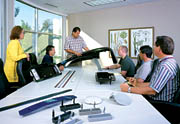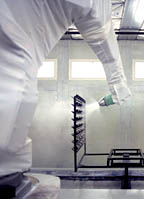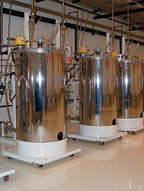

Starting up a new paint facility with the idea of producing Class “A” automotive exterior finishes is a challenging undertaking. American Autocoat has constructed a sound business plan and is already ahead of schedule in lining up customers. A primary reason for their early success is the care and attention to detail that went into the planning, design and construction of the system.
It started with a perception by Scott Skoog that there was a need for exceptional quality and dependability in the supply of painted parts for automotive manufacturers. Skoog has a long history of working in the automotive industry, and he identified paint on plastic as the main problem his previous employer had with suppliers.
This gave him the idea of starting his own facility, and it also provided insight into the quality that he would need to make it work. “Our goal was to develop a line that will put out a consistent, durable, high-quality painted product day after day.”
He constructed a facility plan and began a nine-month process of planning and investigating what would be needed to make the system meet the quality expectations of the automotive industry. He took it to the Ford Motor Co., General Motors Corp. and others to share ideas and gather additional input on what was needed to provide first-class service to these demanding customers.
They also began working with DuPont Automotive Systems (Troy, MI), which helped develop and design the system and agreed to support the process with an on-site, state-of-the-art laboratory and technical assistance for paint performance testing. Another key contributor to the design and layout of the system was Belco Industries (Belding, MI). They became involved in the early stages and worked in partnership with American Autocoat to sort through equipment options and come up with the best system.
Working with the automotive manufacturers, key technical support and Tier One companies, Skoog was able to construct a system with exceptional features for turning out one of the most demanding painted products in the marketplace.
They ultimately spent a year and a half in layout and planning of the system. With extensive research and consultation with potential customers, American Autocoat developed an innovative plan to provide “the best of the best.”

Design specifications
The system is designed to provide the consistent, high-quality product that Skoog envisioned. He feels that the efficiency and careful attention to detail in the system provide him a competitive edge by reducing waste and satisfying his customers.
The system is designed with a work opening that is 60 inches high and 100 inches wide, providing excellent flexibility for different sizes and types of parts. The conveyor (provided by Engineered Conveyors Inc., Kokomo, IN) design speed is 12 fpm, a comfortable speed for application and high-volume production.
The washer is constructed of type 304L stainless steel for clean operation, corrosion resistance and easy maintenance. Pretreatment chemicals are supplied by Henkel Surface Technologies (Madison Heights, MI).
A forced-air blow-off (60 seconds at ambient temperature) is used to remove excess moisture from the parts as they exit the washer.
The moisture-drying oven features a high-velocity discharge system to ensure that there is not residual moisture on the parts prior to application of the coating. The oven dwell time is 10 minutes at an operating temperature of 200?F. The recirculation air to the burner is filtered with high-temperature filters to reduce the risk of particulate being deposited on the cleaned surface.
Three downdraft, dry-filter paint booths supplied by Precise Finishing System (Howell, MI) are used for application. The first booth is used for application of an adhesion promoter, the second booth is used for basecoat application, and the last booth is used for clearcoat. The booths are designed for up to 80% recirculation of exhaust air to reduce the cfm of exhaust to the atmosphere. The booths have an automatic airflow-balancing system that uses variable-speed fans to maintain good air movement inside the booth.

Robots at work
Fanuc (Rochester Hills, MI) P-200E, six-axis pedestal-mounted robots are used for application with VersaBell electrostatic rotary atomizers. The P-200E features a heavy payload (15 kg at wrist, 15 kg in outer arm) and extremely fast acceleration and deceleration motion.
This provides durability and increases spraying time, allowing more area to be covered by the same robot. With a constant application speed, the P-200E with the VersaBell provides consistent film build and improved finish appearance. The PaintWorks software is easy-to-use and provides a Windows graphical interface for system programming, operation and maintenance.
The robots are also equipped with wrist-mounted two-component mixing capability when plural-component materials are used. Color-change valves mounted close to the applicator reduce paint waste and color-change time. In-arm hardware and enhanced motion software allow fast “on-the-fly” applicator parameter changes, providing improved paint quality, film build consistency and less paint overspray.
The VersaBell has miniature paint shutoff valves integrated into the manifold body, close to the bell cup, to minimize material waste and cleaning time. A unique bell-cup and shaping-air-ring design provides adjustable pattern capability. The high-speed, air-bearing turbine (60,000 rpm) provides application flexibility.
The high-voltage cascade mounted within the bell body utilizes a microprocessor-based control system. Setup and diagnostics are easily performed with a PC-based user interface via an Ethernet connection.

Pig-able supply system
Supply of liquid paint to the spray equipment has long been one of the keys to efficiency and material waste, not to mention a very expensive item in systems with a lot of colors. Pig-able paint-circulation systems have helped provide efficient paint use, reduced cleaning solvent use and affordable installations for unlimited numbers of colors.
A pig-able system has unique design characteristics that allow the lines of one color to be flushed and used for another color. The paint supply line can be flushed using a small plastic plug, referred to as a “pig.” Using a pig to quickly flush paint lines for color change avoids the need for a separate circulation line for every color.
The following cleaning sequence is used with a pig-able system:
1. Shut off the paint supply.
2. Blow the paint back to the barrel with an air push.
3. Blow a pig through the supply line to flush any remaining paint solids.
4. Disconnect the paint-supply source.
5. Load a small amount of solvent (1 quart to 1 gallon is typical) and push it through the supply line with a pig.
6. One additional air/solvent push, if necessary.
A typical cycle for color change takes around five to 10 minutes. The paint-circulation system is an all-stainless-steel design with 16 pig-able lines. They saved a great deal of capital investment, and the pig-able system dramatically reduces waste solvent and paint.

Controlling the environment
To provide a consistent atmosphere for paint application, the booths are enclosed in a climate-controlled room that can hold the relative humidity at the desired level of 70% and control temperature within 2?F of the set point. Each spray booth has independent environmental controls for humidity and temperature.
The cure oven has a dwell time of 30 minutes with two independent heat zones. The oven’s operating temperature is 290?F and, like the dry-off oven, the recirculation air is filtered to reduce dirt in the system. The cure oven is elevated to provide better use of floor space.
100% of the air exhausted from the system is routed to a twin-bed, ceramic regenerative thermal oxidizer (RTO). The RTO delivers over 95% VOC destruction with a lower hourly operating cost than a standard thermal oxidizer or catalytic system. It also provides greater flexibility for variances in the process air volume and solvent concentration.
Product travels through the system on an inverted power-and-free conveyor system. With the enclosed track inverted, the parts are protected from chain debris. The power-and-free provides flexible movement of parts through the system. It is designed to travel at a maximum of 18 fpm and is currently being run at 10 to 12 fpm. The system is controlled through an Allen Bradley (Milwaukee) PLC system.

Products to be painted
“Our focus is on parts requiring an automotive exterior finish to match the vehicle,” Skoog says. “We have customers that are looking for paining on body side moldings, fascia, mirrors, spoilers, ditch moldings, luggage carriers, door handles, “A” pillars and license-plate appliqu¿”
They are currently in full production with over two million ditch moldings (uni-bond extrusions) a year. They are in the launch phase on two license-plate appliqu¿ a lift-gate handle, an “A” pillar and a luggage-rack system to support a variety of GM production vehicles.
The system is located in a 47,000-square-foot facility. The building was purchased in September 2002. Acting as their own general contractors, Skoog and the plant’s manager, Phil Frisbie, began work on the building in October 2002. The system was installed and ready for operation by May of 2003.
Technology and innovation have been the key to this system from the very beginning. With a combination of in-house expertise, vendor cooperation and careful analysis of the potential customer base, American Autocoat has constructed a truly world-class paint facility that is equipped to meet the demands of the most demanding manufacturers.
The system was designed with an attention to detail based on value and capability first, and the cost was not the most critical factor in equipment selection. Capital investment was made where it would provide superior operation. Allowance has been made for expansion as business demands it over the years.
With exceptional quality goals and with sufficient capacity, chances are good that you will one day own a vehicle with parts that were painted at American Autocoat. With the high-quality capability of this system, it is possible that day may come soon.



